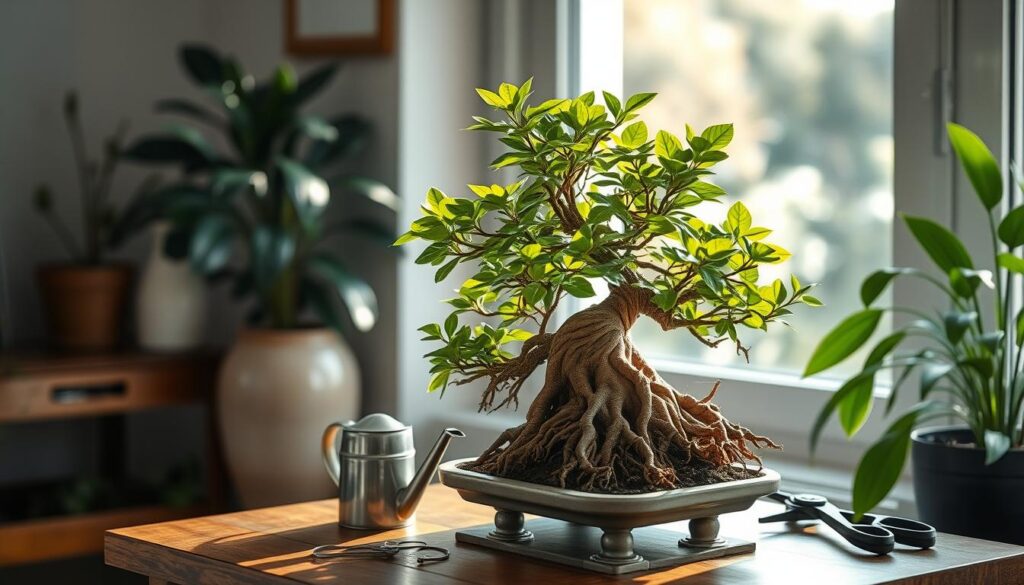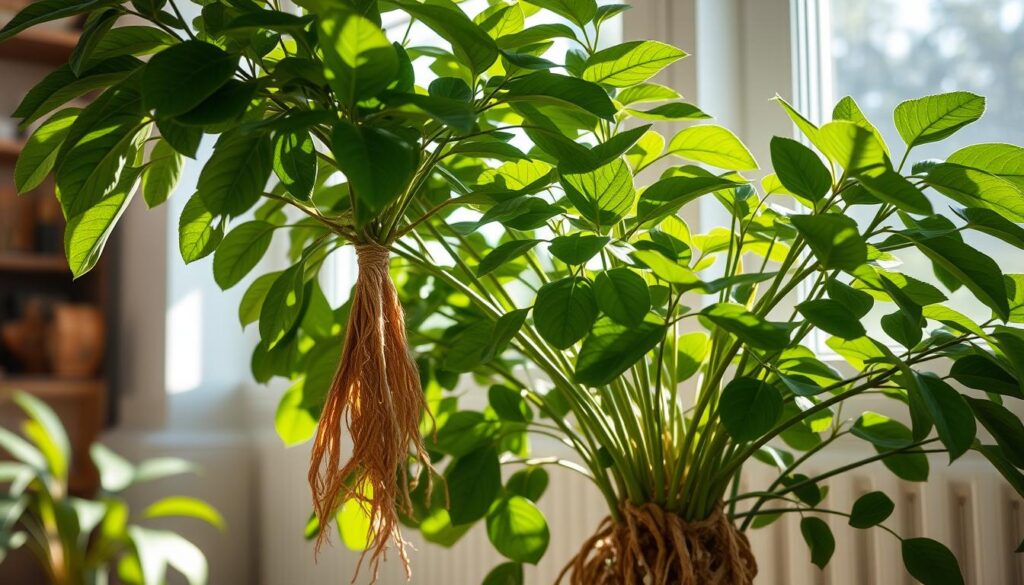Did you know Ficus Ginseng can clean up to 80% of indoor air pollutants like ammonia and formaldehyde? This fact shows it’s a top choice in the plant world. Let me tell you why Ficus Ginseng is a must-have for your home.
Ficus Ginseng, also known as Ficus Microcarpa, comes from Southeast Asia. It’s a small plant with a unique look, perfect for bonsai lovers. In Feng Shui, it stands for strength and long life, bringing luck and wealth to spaces.
This plant is easy to care for, fitting in USDA zones 9 to 11. It’s not just pretty; it also helps reduce stress. Its roots grow above the soil, making it a standout piece that sparks conversations.
Key Takeaways
- Ficus Ginseng removes up to 80% of certain indoor air pollutants
- It symbolizes strength and longevity in Feng Shui practice
- The plant thrives in USDA hardiness zones 9 to 11
- It features a unique above-soil root structure
- Ficus Ginseng acts as a natural stress reducer
Introduction to Ficus Ginseng
I’ve always been drawn to the unique charm of Ficus Ginseng. It’s a plant that connects indoor gardening with ancient traditions. It’s popular among plant lovers for its toughness and beauty.
Origin and botanical characteristics
Ficus Ginseng, also known as Ficus microcarpa, comes from Southeast Asia, Australia, and parts of the Himalayas. In the wild, it can grow into huge trees, reaching up to 110 feet tall and 250 feet wide.
As a houseplant, it grows to about six or seven feet tall. Its shiny leaves and compact size make it perfect for indoor spaces. It’s loved for its ability to thrive in many conditions, making it a top choice in indoor gardening.
Significance in Feng Shui practice
In Feng Shui, Ficus Ginseng is very important. It symbolizes resilience, strength, and a long life. Its ability to adjust to different places shows the Feng Shui idea of living in harmony with our surroundings.
There are between 800 and 2000 types of Ficus bonsai. This gives many options for those wanting to use it in Feng Shui. Adding a Ficus Ginseng brings beauty and positive energy into your home or office.
The Symbolism of Ficus Ginseng in Feng Shui
Ficus Ginseng is a key plant in Feng Shui. It symbolizes resilience, strength, and longevity. Its root structure shows stability and growth, fitting Feng Shui’s harmony and balance.
This plant is known for drawing in positive energy. Many think it brings wealth and luck to homes and offices. Its lasting nature is a strong symbol of success in life.
“The Ficus Ginseng is like a silent guardian, steadily cultivating well-being and good fortune in any space it occupies.”
Let’s compare Ficus Ginseng with other popular Feng Shui plants:
| Plant | Symbolism | Care Requirements |
|---|---|---|
| Ficus Ginseng | Prosperity, abundance | Bright indirect light, humid environment |
| Money Tree | Financial luck | Bright indirect light, quick-draining soil |
| Jade Plant | Luck, prosperity | Bright light, slightly acidic soil |
| Lucky Bamboo | Fortune, unity | Indirect light, rich well-drained soil |
Remember, Ficus Ginseng grows best in USDA hardiness zones 9 to 11. It needs at least 6 hours of sunlight a day. This makes it perfect for bright spots in your home.
Ideal Placement for Ficus Ginseng in Your Home
I love adding Ficus Ginseng to my home garden. It brings nature indoors and boosts positive energy. Let’s find the best spots for your Ficus Ginseng to grow well and improve your home’s energy.
Living room and entry hall placement
The living room and entry hall are great spots for Ficus Ginseng. These areas draw in positive energy and help your family luck. Having a Ficus Ginseng near the door makes your home feel welcoming to guests and family.
East and Southeast sectors
Think about putting your Ficus Ginseng in the East or Southeast parts of your home. The East boosts creativity and motivation. The Southeast helps with social ties and making money. I’ve seen my Ficus Ginseng do well here, making my home more peaceful.
Areas to avoid
While Ficus Ginseng is flexible, some spots are better left out. The Northwest, Southwest, and Northeast aren’t great for big plants. Also, bedrooms and kitchens aren’t good places for it. Remember, feng shui and ecology value balance.
| Placement | Benefits | Considerations |
|---|---|---|
| Living Room | Enhances family luck | Ensure 6 hours of bright sunlight |
| Entry Hall | Welcomes positive energy | Avoid cool drafts |
| East Sector | Boosts creativity | Maintain 60-75% humidity |
| Southeast Sector | Improves social relationships | Water when soil surface is dry |
Follow these tips to make a great home for your Ficus Ginseng. It will help keep your home full of positive energy. Just think about the plant’s size and the room’s size to keep everything in balance.
Caring for Your Ficus Ginseng Bonsai
As a botany enthusiast, I’ve learned that caring for a Ficus Ginseng Bonsai is both an art and a science. This unique plant needs special care to grow well. It combines horticulture skills with artistic shaping.
Soil and Fertilizer Requirements
Ficus Ginseng Bonsai does well in soil that drains well. I mix 60% aggregate with 40% organic matter for the soil. This keeps the soil draining right and holds onto nutrients. When it’s growing, I feed it every two weeks with a balanced, liquid fertilizer. In the off-season, I cut back to once a month.
Watering and Light Needs
Watering is key for these plants. I use soft water at room temperature to keep the soil just right, not too wet. The Ficus Ginseng Bonsai needs a lot of light, about 6-8 hours a day. I put mine in bright, indirect sunlight to avoid burning the leaves.

Pruning Techniques
Pruning is vital for keeping the bonsai looking good and growing well. I prune in spring and summer, shaping the tree and taking out dead or yellow leaves. This keeps the plant healthy and makes it look better.
| Care Aspect | Frequency | Notes |
|---|---|---|
| Watering | 1-2 times weekly | When soil surface is dry |
| Fertilizing | Every 2 weeks (summer) | Every 4 weeks (winter) |
| Repotting | Every 2 years | In spring, using fresh soil mix |
By following these care tips, your Ficus Ginseng Bonsai can live for many years. It will become a beautiful piece of art in your home.
Plants: Understanding Ficus Ginseng’s Role in Indoor Gardening
Ficus Ginseng is a big deal in indoor gardening. It grows between 31-61 cm, making it perfect for small spaces. This plant brings nature indoors, making our homes feel more alive.
It’s great for beginners in indoor plants. It likes the temperature in our homes and needs sunlight to grow. Just water it when the soil feels dry, making it easy for busy people to care for.
Having Ficus Ginseng indoors is good for the air we breathe. It helps clean the air, making our homes healthier. But, pet owners should keep it away from their pets as it can be harmful.
- Thrives in USDA Zones 9a to 11b
- Prefers temperatures between 60-80°F (15-26°C)
- Needs well-draining soil with perlite or sand
- Benefits from regular pruning for healthy growth
Ficus Ginseng is a long-lasting plant. It can live for many years and bounce back from tough seasons. With the right care, like repotting every 2-3 years, it can even bloom.
Adding Ficus Ginseng to your indoor garden is fulfilling. Its unique look and easy care make it a top choice for improving our indoor spaces.
Health Benefits of Ficus Ginseng
I’m thrilled to talk about the amazing health benefits of Ficus Ginseng. This plant is more than just beautiful in the world of botany. It offers many benefits that go beyond looks.
Air Purification Properties
Ficus Ginseng acts as a natural air filter, making it great for your home. As someone who loves horticulture, I’ve found it’s good at removing chemical pollutants from the air. It’s especially good at getting rid of toxins like ammonia and formaldehyde, which are in furniture and cleaning products.

Stress Reduction and Mood Enhancement
Ficus Ginseng is amazing for reducing stress. Taking care of this bonsai tree can make you feel accomplished, which is good for your mental health. In fact, studies show that indoor plants can help prevent sore throats, coughs, and dry skin. This is because they increase the humidity in a room.
Here are some interesting facts about Ficus Ginseng:
- It’s from Taiwan and Malaysia
- Its roots look like ginger trees
- It’s one of six Ficus species used in bonsai gardening
- It prefers rooms above 68°F
While Ficus Ginseng has many health benefits, it’s important to be careful with it. The plant is toxic if eaten, so keep it away from pets and kids. With the right care, this beautiful plant can be a lasting part of your indoor garden, even outliving its owner and becoming a family treasure.
Aesthetic Appeal and Decor Enhancement
I adore how Ficus Ginseng changes indoor spaces with its unique look. This plant, part of our indoor plants, has a special root that looks like ginger. It adds an exotic touch. Its shiny leaves also brighten up any room.
As someone who loves gardening, I’ve seen that Ficus Ginseng goes well with many decor styles. It fits whether your home is modern or traditional. Its unique trunk and aerial roots make a great focal point, enhancing your indoor plants.
| Form Characteristic | Visual Impact | Design Function |
|---|---|---|
| Upright growth | Adds height | Creates vertical interest |
| Arching branches | Softens appearance | Balances rigid elements |
| Rounded canopy | Medium visual weight | Provides a sense of fullness |
| Glossy leaves | Reflects light | Brightens spaces |
The Ficus Ginseng has a medium texture and rounded shape, creating a balanced look. It’s perfect for those new to indoor gardening. It not only makes your space look better but can also lower stress and increase creativity. It’s great for both homes and offices.
Propagation Methods for Ficus Ginseng
Ficus Ginseng is a favorite in botany and horticulture. It can be grown using stem cutting and air layering. I’ll guide you through both methods to grow your own Ficus Ginseng.
Stem Cutting Technique
Stem cutting is an easy way to propagate Ficus Ginseng. First, I pick a healthy stem. Then, I cut it below a node and remove the lower leaves. Next, I put the cutting in water or potting mix.
Air Layering Method
Air layering is another great way to grow Ficus Ginseng. I take a branch section, apply rooting hormone, and wrap it in moist sphagnum moss. Then, I cover it with plastic.
Once roots appear, I cut the branch and transplant it. This method takes a few months but gives you bigger plants.
| Propagation Method | Time Frame | Success Rate |
|---|---|---|
| Stem Cutting | 4-6 weeks | 70-80% |
| Air Layering | 2-5 months | 85-95% |
For both methods, keeping the area moist and warm is key. I keep it at 17-27°C and humid. Regular misting and avoiding drafts helps ensure success. With patience and care, you’ll soon have new Ficus Ginseng plants for your garden.
Common Problems and Troubleshooting
As a plant lover, I’ve faced many issues with Ficus Ginseng. These problems can impact your indoor plants’ health. Let’s look at common problems and how to fix them.
Leaf Dropping Issues
Ficus Ginseng often drops leaves when it’s stressed. This can be due to changes in its environment or not being cared for right. Keeping the watering and humidity steady helps prevent this.
Yellowing Leaves and Solutions
Yellow leaves mean there’s a problem. In my experience, it could be from too much water, bad drainage, or not enough light. Changing these things usually fixes the issue. Ficus Ginseng likes bright, indirect light.
| Problem | Possible Cause | Solution |
|---|---|---|
| Leaf Dropping | Environmental stress | Maintain consistent care routine |
| Yellow Leaves | Overwatering or poor light | Adjust watering and light exposure |
| Brown Leaf Tips | Low humidity | Increase humidity with a pebble tray |
| Pale Leaves | Too much direct sunlight | Move to a spot with indirect light |
Fixing these issues quickly will help your Ficus Ginseng flourish. Regular care and paying attention to your plant’s needs keeps your indoor plants looking great.
Incorporating Ficus Ginseng in Feng Shui Design Principles
Adding Ficus Ginseng to Feng Shui design can change your living space. This plant is perfect for modern gardens and respects old traditions. Let’s see how to use it in your home.
Put Ficus Ginseng in the east or southeast of your home. These spots have wood energy, which boosts creativity and social connections. It’s great in living rooms and entryways, helping with family luck. Remember, big plants are best in large areas.
For more wealth, put Ficus Ginseng in the southeast corner. It draws in prosperity and good luck. Garden lovers will like its ability to clean the air, adding health benefits too.
“Ficus Ginseng brings harmony and luck to any space, making it a top choice for Feng Shui practitioners.”
Don’t put Ficus Ginseng in bedrooms or the house center. These spots need different energy. Use it in common areas for everyone’s benefit.
| Direction | Feng Shui Element | Benefits |
|---|---|---|
| East | Wood | Creativity, Growth |
| Southeast | Wood | Wealth, Prosperity |
| South | Fire | Recognition, Fame |
Thoughtfully placing Ficus Ginseng means more than gardening. It’s about creating positive energy in your home. It’s a lovely way to mix nature with intentional living.
Conclusion
As I finish this look at Ficus Ginseng in Feng Shui, I’m impressed by its many uses. This plant is both beautiful and meaningful, making it great for improving any space.
Ficus Ginseng is easy to care for, fitting well in homes or offices. It cleans the air and helps reduce stress, which is good for Feng Shui. Its special look and cultural value set it apart in indoor plants.
To get the most from Ficus Ginseng, know where to put it and how to take care of it. Remember, balance is important in Feng Shui. Adding this plant thoughtfully can make your space better for prosperity and positive vibes.
FAQ
What is the origin and significance of the Ficus Ginseng plant?
What does the Ficus Ginseng represent in Feng Shui?
Where should I place my Ficus Ginseng in the home for optimal Feng Shui benefits?
How do I care for my Ficus Ginseng bonsai?
What role does Ficus Ginseng play in indoor gardening?
Does Ficus Ginseng have any health benefits?
How can I propagate my Ficus Ginseng?
What are some common problems with Ficus Ginseng, and how can I troubleshoot them?
How can I incorporate Ficus Ginseng into my Feng Shui design?
Source Links
- 10 Advantages Of Having A Ficus Ginseng
- Ficus Ginseng Bonsai Care: Essential Tips for Healthy Growth
- Ficus Ginseng Bonsai Tree – Best Feng Shui Plants For the Home
- How To Care For Your Ficus Ginseng Bonsai
- How to Grow and Care for Ginseng Ficus | Gardener’s Path
- Ficus Ginseng Bonsai Care: Essential Tips for Healthy Growth
- What are the 7 Lucky Plants for Your Home According to Feng Shui? – Which Should You Avoid?
- Ficus Ginseng Bonsai Care: Essential Tips for Healthy Growth
- Ficus Ginseng Care Instructions
- Care guide for the Ficus Bonsai tree (Retusa and Ginseng) – Bonsai Empire
- How to Grow and Care for Ginseng Ficus Bonsai
- Ficus Ginseng Care Guide
- Ficus ginseng, aka the bonsai tree: the perfect starter plant
- Ficus Ginseng Is a Perennial
- Ficus Bonsai Tree Care Guide: The Ultimate Care Guide
- Health Benefits of Bonsai Ginseng Ficus.
- Ficus Ginseng Bonsai
- Benefits of Bonsai Tree on your Body and Soul
- ENH1172/EP433: Landscape Design: Aesthetic Characteristics of Plants
- Workplace Aesthetics: You Need More Plants! – Tropex
- How Do I Propagate My Ficus Ginseng?
- Ficus Ginseng Care Instructions
- Propagating A Ficus Tree: How To Propagate Weeping Fig
- What’s Wrong with My Plant? How to Fix 10 Houseplant Problems
- Preventing, Diagnosing, and Correcting Common Houseplant Problems
- The One Plant You Should Never Keep In Your Home, According To Feng Shui – House Digest
- Top 50 lucky plants for home to attract wealth and positivity
- FAQs
- 12.6 - Conclusion and references | Plants in Action
- sciencefairconclusion.pages


